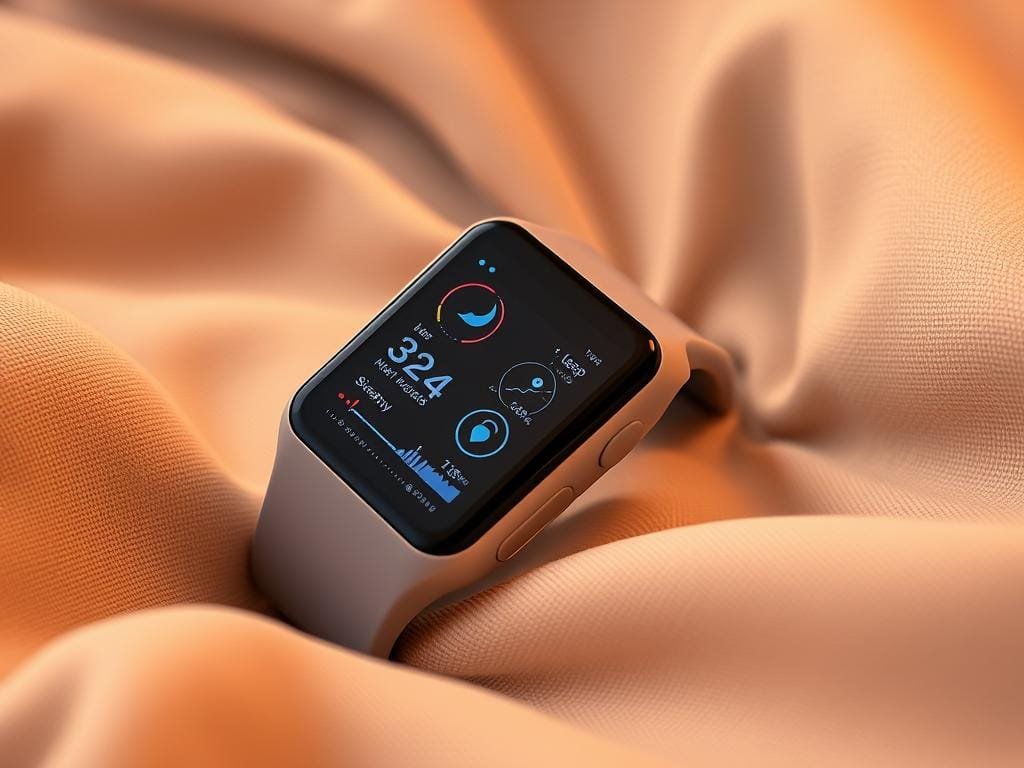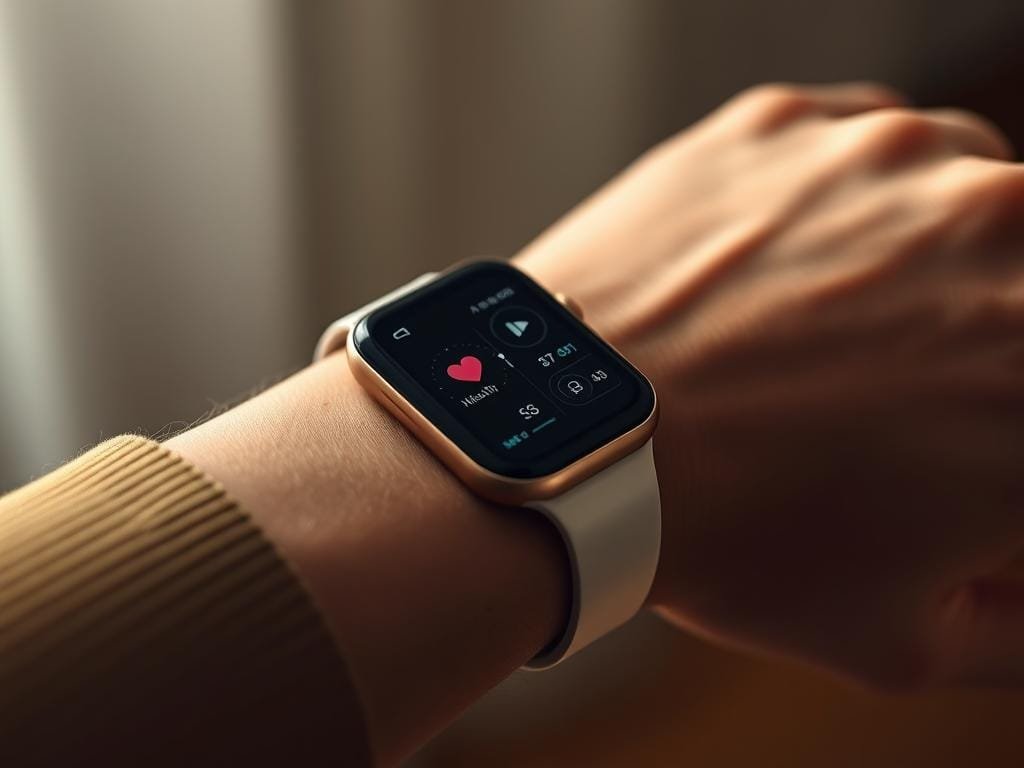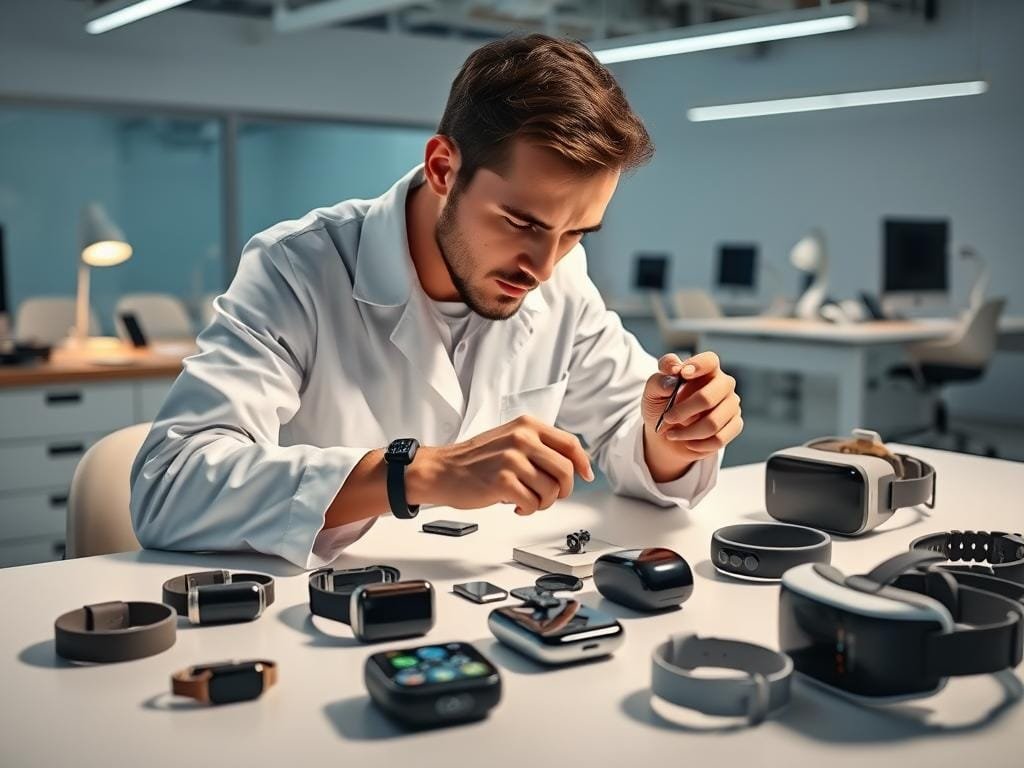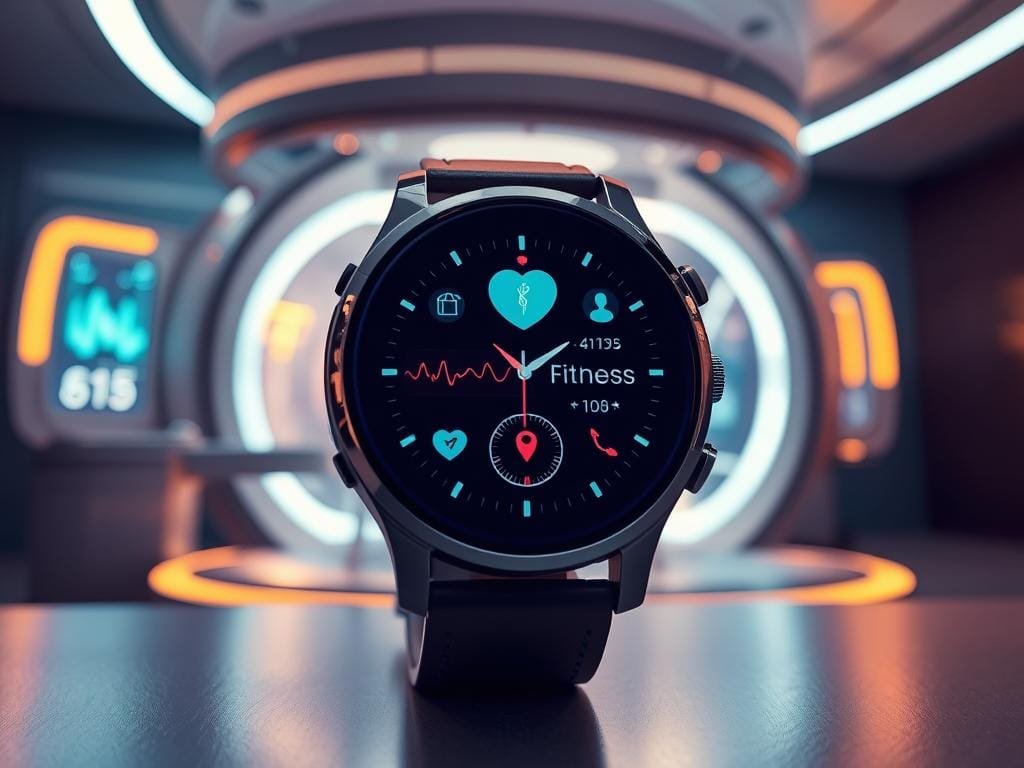You’re now part of a growing group that uses wearable tech for health to track and boost their well-being. The wearable tech market growth has seen a big jump in recent years.
By adding these devices to your daily life, you’ll likely see health and fitness improvements. You can use real-time health data to tweak your habits for better health. For example, biohacking with technology can enhance your physical and mental health.
Key Takeaways
- Wearable devices offer improved health monitoring and fitness tracking.
- The wearable tech market has experienced significant growth.
- Real-time health data enables personalized daily adjustments.
- Biohacking with technology can optimize physical and mental performance.
- Wearable tech can lead to better overall health and well-being.
The Evolution of Wearable Technology
Wearable technology has changed a lot over the years. It now helps you with health, fitness, and staying connected. This change is thanks to new tech and people wanting devices that help them feel better.
From Pedometers to Smart Ecosystems
It all started with simple pedometers that counted your steps. Now, these devices are smart systems that track many health metrics. They give you insights and even guide workouts.
Modern smartwatches can track your heart rate, blood oxygen, and sleep. They give you a full picture of your health. Wearables have also gotten better at working with other devices. They connect with phones, letting you get notifications, control music, and even pay with your wrist. This makes tech more accessible and easy to use.
Current Market Landscape and Growth Trends
The wearable tech market is growing fast. A recent study says it will keep growing, thanks to new tech and more people wanting these devices. This growth is expected to continue for a few years.
| Segment | 2022 | 2023 | 2024 (Projected) |
|---|---|---|---|
| Fitness Trackers | 120 million | 130 million | 140 million |
| Smartwatches | 80 million | 90 million | 100 million |
| Health Monitors | 20 million | 25 million | 30 million |
Wearable tech is becoming a big part of our lives. It helps us monitor our health, stay connected, and reach our fitness goals. It’s changing how we live every day.
“The future of wearable technology is not just about the devices themselves, but about how they integrate into our daily lives, making us healthier, more connected, and more productive.”
Understanding wearable tech’s evolution helps us see its value in our lives. It guides us in using these devices to reach our goals.
Understanding Different Types of Wearable Technology
The world of wearable technology is vast. It includes devices that track health, fitness, and connect us daily. Knowing the different types and what they do can help you pick the best one for you.
Health and Medical Wearables
Health and medical wearables watch your vital signs and health metrics. They give insights into your well-being. For example, some smartwatches can record your heart rhythm and share it with doctors.
Key Features of Health and Medical Wearables:
- Heart rate monitoring
- Blood oxygen level tracking
- ECG functionality
- Fall detection and emergency SOS
A report says the market for medical wearables is growing fast. This is because more people want to monitor their health from home and prevent illnesses.
Fitness and Activity Trackers
Fitness trackers help you keep an eye on your physical activity. They track steps, distance, calories, and offer workout guides. Many also give you tips to reach your fitness goals.
Notable Features of Fitness Trackers:
- Step tracking and distance measurement
- Calorie burn tracking
- Guided breathing sessions
- GPS tracking for outdoor activities
A fitness expert says using a tracker can improve your workouts. It gives you insights into how you’re doing and how to get better.
Smart Connectivity Devices
Smart devices, like smartwatches and bands, make your day easier. They let you get notifications, control music, and even pay without touching anything. Many also work with virtual assistants, so you can do things with just your voice.
Key Benefits of Smart Connectivity Devices:
- Notification management
- Music control
- Contactless payments
- Voice assistant integration
In summary, knowing about the different wearable technologies helps you find the right one. Whether you need to monitor health, track fitness, or stay connected, there’s a device for you.
Setting Up Your Wearable Tech for Health Monitoring
To get the most out of your wearable device, setting it up right is key. These devices track your heart rate, blood oxygen, sleep, and stress levels. By setting these features up correctly, you’ll understand your health better.
Configuring Heart Rate and Blood Oxygen Monitoring
Heart rate and blood oxygen tracking are vital on many devices. Make sure your device fits snugly and follow the setup guide. Getting it right is important for accurate readings.
- Ensure a snug fit on your wrist.
- Follow the manufacturer’s calibration instructions.
- Adjust settings in the companion app as needed.
Implementing Effective Sleep Tracking
Sleep tracking offers insights into your rest and recovery. Wear your device to bed and turn on sleep tracking. Some devices track sleep automatically, while others need manual input. Consistency is key for accurate sleep data.
- Wear your device to bed.
- Enable sleep tracking in the device settings.
- Review your sleep data regularly to identify patterns.

Setting Up Stress Management Features
Many devices now have stress management tools like breathing exercises. To use these, go to the stress section in your device’s settings and follow the prompts. Using these tools regularly can help manage stress. For more on wearable tech in health, check out this article on Medium.
Connecting to Healthcare Providers and Services
Some devices can link to healthcare services for better care. Check if your device can do this and follow the setup guide. This lets you share health data with doctors or get health advice.
- Check if your device supports connectivity to healthcare services.
- Follow the manufacturer’s instructions for setup.
- Explore the benefits of sharing your health data with healthcare providers.
Maximizing Fitness Performance with Wearable Devices
Wearable tech gives you insights into your fitness and helps you make better choices. It’s a must-have for athletes and fitness lovers. It offers features to boost your training and performance.
Creating Custom Workout Profiles
Wearable tech lets you create workout profiles that fit your needs and goals. You can track your progress and change your training as needed. For example, you can set up profiles for running, cycling, or strength training. You’ll get feedback and guidance tailored just for you.
Tracking and Analyzing Performance Metrics
Wearable devices track important metrics like heart rate, pace, distance, and calories burned. By looking at these, you understand your fitness level better. A study on PMC shows these devices give accurate data. This helps you improve your training.

Setting Achievable Fitness Goals and Milestones
Setting realistic fitness goals keeps you motivated and tracks your progress. Wearable devices help you set and reach milestones, like completing workouts or setting new personal records. Breaking down big goals into smaller ones helps you stay focused and motivated.
Using GPS and Route Planning Features
GPS and route planning are key for outdoor activities like running, cycling, or hiking. Wearable devices with GPS track your route, distance, and pace. They also help you find new routes and avoid routine. For more on wearable tech advancements, like 5G, check Digital Vista Online.
Key benefits of wearable devices for fitness include:
- Personalized insights and guidance
- Accurate tracking of performance metrics
- Customizable workout profiles and goals
- GPS and route planning features for outdoor activities
By using these features, you can improve your fitness and reach your goals more effectively.
Enhancing Daily Connectivity Through Wearable Tech
Wearable technology is changing how we connect with the world. It lets us get notifications, control music, and even pay with our wrists. These devices are now key to our daily lives.
Customizing Notification Settings for Productivity
Wearable tech keeps you connected without needing to check your phone all the time. You can set up your device to only show important alerts. This boosts your productivity.
It’s important to know how to sort alerts. Most devices let you choose what’s urgent. For example, you might get alerts for calls, messages, and events, but not for everything.
Configuring Voice Assistants and Commands
Voice assistants like Siri and Google Assistant are big in wearable tech. They let you do things like set reminders and make calls without touching your device. This makes life easier and safer, like when you’re driving.
To use voice assistants well, learn their commands. You can dictate texts, check the weather, or get directions. This is all without touching your device. As explained in an article on IoT, voice assistants make our devices more connected and easy to use.
Setting Up Digital Payments and Access Controls
Wearable devices also make digital payments and access controls easy. You can use Apple Pay or Google Pay to pay without cash or cards. Some devices even let you unlock doors or secure areas.
To use digital payments, link your card to your wearable through an app. Then, you can pay by holding your device near a payment terminal. This is not only easy but also safer than handling cash or cards.

| Feature | Description | Benefit |
|---|---|---|
| Customizable Notifications | Allows users to prioritize notifications based on importance | Enhances productivity by reducing distractions |
| Voice Assistants | Enables hands-free control over various tasks and smart devices | Improves convenience and safety |
| Digital Payments | Facilitates quick and secure transactions directly from the wearable | Streamlines daily interactions and enhances security |
Wearable tech is getting better, with more features for daily life. We’ll see better battery life and new health and fitness uses. By using what we have now, we can make our daily lives more productive and connected.
Troubleshooting Common Wearable Technology Issues
To get the most out of your wearable device, it’s key to know how to fix common problems. Wearable tech is super helpful but can face issues like connectivity problems, battery drain, and data inaccuracies. By tackling these problems, you can make your wearable work better and get the most out of it.
Resolving Syncing and Connectivity Problems
Syncing and connectivity issues can be really frustrating. Here are some steps to help:
- Make sure your wearable and phone are compatible and Bluetooth is on.
- Restart both your wearable and phone to refresh the connection.
- Check for software updates on both to keep them current.
- If problems continue, try resetting your wearable to its factory settings.

Addressing Battery Drain and Optimization
Battery life is key for wearable tech. Here’s how to make it last longer:
- Lower your screen brightness and set a shorter timeout to save battery.
- Turn off GPS, heart rate monitoring, or notifications when not needed.
- Update your device software often for better battery life.
- Charge your device regularly and avoid overcharging.
Improving Data Accuracy and Sensor Performance
Getting accurate data is important for your health and fitness. Here’s how to improve it:
- Make sure your wearable fits right and is adjusted properly.
- Clean the sensors often to avoid dirt or sweat affecting data.
- Calibrate your device as the maker suggests.
- Keep your device’s software up to date for better data.
By following these steps, you can greatly improve your wearable tech experience. This ensures your device gives you accurate data and works well. As wearable tech gets better, knowing how to fix common problems will help you get the most out of it.
Interpreting Your Personal Data for Meaningful Insights
To get the most out of your wearable tech, you need to understand the data it gives you. Wearable devices track many health and fitness metrics. This includes heart rate, sleep, exercise, and nutrition. By knowing this data, you can make choices to improve your health.
Understanding Health and Fitness Metrics in Context
Health and fitness metrics are more useful when seen in context. For example, heart rate data shows your heart health. But it’s also affected by stress, caffeine, and the environment. By thinking about these factors, you can understand your body better and make changes.
Some important metrics to watch include:
- Heart Rate Variability (HRV): Shows how your body handles stress and recovery.
- Sleep Quality: Tracks how well you sleep, helping you rest better.
- Activity Levels: Monitors your daily activity and exercise, encouraging more movement.
Using Trend Analysis to Make Lifestyle Improvements
Trend analysis looks at your data over time to spot patterns and changes. This helps you see how different things affect your health and fitness. For instance, you might find that morning exercise improves your sleep, or that caffeine raises your heart rate.
To use trend analysis well:
- Track Your Metrics Regularly: Consistency is key to spotting important trends.
- Compare Data Over Time: Look for changes and patterns in your metrics.
- Adjust Your Habits: Use your insights to make smart lifestyle changes.
By understanding your personal data and using trend analysis, you can learn a lot about your health and fitness. This lets you make choices based on data, improving your lifestyle for better health.
Selecting the Ideal Wearable Technology for Your Lifestyle
Choosing the right wearable tech means thinking about your health and fitness goals. With so many options, picking the best one can be tough.
Assessing Your Primary Health and Fitness Goals
To find the perfect wearable, first figure out what you want to achieve. Do you want to monitor your heart rate, track your daily steps, or check your sleep? Different devices focus on different areas, so knowing what you need is key.
If you want to boost your heart health, look for a smartwatch for health monitoring with ECG and alerts for heart rhythm issues.
Evaluating Technical Specifications and Features
After setting your goals, look at the tech specs and features of different wearables. Think about battery life, water resistance, and the sensor technology used.
| Feature | Basic Fitness Tracker | Advanced Smartwatch |
|---|---|---|
| Heart Rate Monitoring | Yes | Yes |
| GPS Tracking | Yes | Yes |
| ECG Monitoring | No | Yes |
| Battery Life | Up to 7 days | Up to 2 days |
Considering Ecosystem Compatibility and Integration
It’s also important to think about compatibility with your other devices. If you use Apple Health or Google Fit, choose a wearable that works well with them.
“The best wearable devices are those that can sync with your existing digital ecosystem, providing a cohesive and streamlined experience.”
Balancing Budget Constraints with Feature Requirements
Lastly, match your budget with the features you need. Fitness trackers for performance vary in price, from affordable to high-end.
- Determine your budget before making a purchase.
- Prioritize the features that are most important to you.
- Consider whether you need any additional services, such as subscription-based health insights.
By carefully considering your goals, tech specs, compatibility, and budget, you can find a wearable that fits your lifestyle and improves your health.
Conclusion: Embracing the Future of Personal Empowerment Through Wearables
Wearable technology is changing fast, and it will greatly impact our lives. The market is growing, leading to new uses that will change how we live.
Wearables will soon be more advanced, helping you manage your health and fitness better than ever. But, we must also think about the privacy and security of our data.
Knowing the good and bad of wearables can help you use them to better your life. You’ll find new ways to keep an eye on your health, get fit, and stay in touch with others.
The future of wearables is bright, and embracing it can open doors to personal growth and empowerment.
FAQ
What is wearable technology, and how does it impact our lives?
Wearable technology are devices you wear, like smartwatches and fitness trackers. They track health and fitness, send notifications, and give insights into your day. This helps you manage your health better.
What are the different types of wearable technology available?
There are many types, like health monitors, fitness trackers, and smart devices. Brands like Apple Watch, Fitbit, and Garmin offer different features for various needs.
How do I set up my wearable device for health monitoring?
To use it for health monitoring, set up heart rate and blood oxygen tracking. Also, track sleep and stress. You might need to connect it to healthcare services too.
Can wearable devices help maximize fitness performance?
Yes, they can. They let you create workout plans, track your progress, and set goals. Features like GPS make workouts better.
How can I troubleshoot common wearable technology issues?
For common problems, try fixing syncing issues and battery life. Check data accuracy too. User manuals and support teams can help.
How do I interpret my personal data from wearable devices?
Understand your health data and use it to improve your lifestyle. Trend analysis helps you make better choices for your health.
What factors should I consider when selecting a wearable device?
Think about your health goals, the device’s features, and if it fits your budget. Also, check if it works with your other devices.
Are there any ethical considerations surrounding wearable technology?
Yes, there are. Consider data privacy, accuracy, and not relying too much on tech. Use devices wisely.
What is the future of wearable technology?
It will get smarter with AI and better sensors. This means more personalized devices for health and sports.
How do I ensure my wearable device is compatible with my existing ecosystem?
Check if it works with your phone or computer. Look at the manufacturer’s info or ask their support team.
What are some examples of wearable tech for sports and fitness?
For sports and fitness, look at GPS watches, heart rate monitors, and fitness trackers from Garmin, Fitbit, and Apple.
